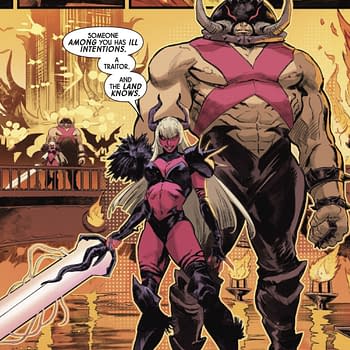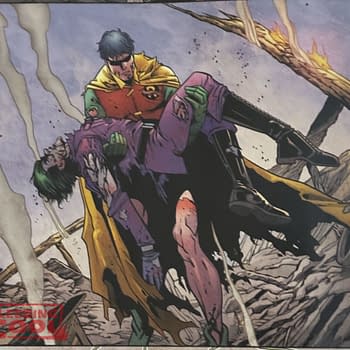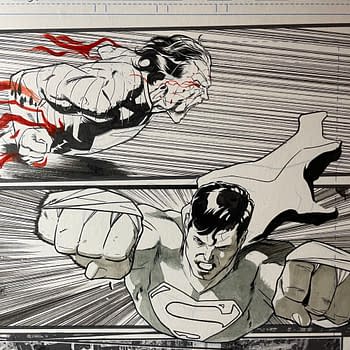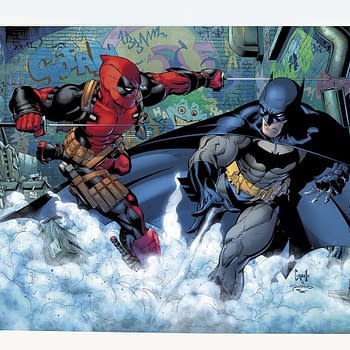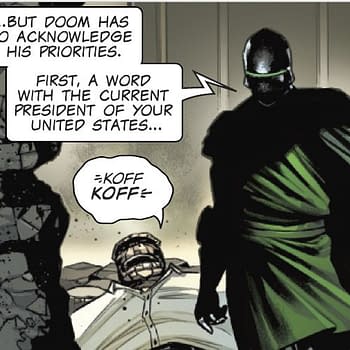Posted in: Comics, Recent Updates | Tagged: Ark Performance, art adams, Comics, entertainment, grant morrison, image comics, jim zub, manga, michael golden, Morita Masanori, neil gaiman, Steve Cummings, wayward, Yauhiko Yoshikazu, Yokoyama Mitsuteru
Image Watch: Talking Wayward With Jim Zub And Steve Cummings
By David Dissanayake
The more I read about the new ongoing Wayward by Image Comics, the more intrigued I became.
Co-created by Jim Zub and Steve Cummings, Wayward is a story about teenage heroine Rori, a half-Irish, half-Japanese girl from Ireland who has moved to Tokyo with her mother for the first time. As an outsider trying to deal with integrating into Japanese culture, Rori begins to experience a supernatural hyper-reality full of Japanese mythological creatures and monsters like Yokai and Bakemono. Steeped in deep character work, Wayward is as much a story about Japanese mythology as it is a coming of age tale. From what I've heard about the series, it sounds a bit like Whedon's Buffy the Vampire Slayer by way of Miyazaki's Spirited Away, and I'm really looking forward to it.
I had a really nice chat with Jim and Steve just ahead of SDCC to hear more about the story, Steve's history in Japan, and what we can expect from their new creator-owned project from Image Comics:
David Dissanayake: To begin I was hoping you could tell us a little about yourselves and your formal training.
Steve Cummings: I've pretty much always wanted to draw comic books and most of my non-D&D free time as a kid was spent drawing. When I was in college I came to Japan for a one year exchange and ended up staying close to 4, during which time I was too poor to travel around so all my free time was spent drawing. In school I was studying Japanese language and literature but after classes I was drawing drawing drawing to the point I started getting offers for work as a penciler from companies in the states. So, no official art training, just lots of time with a pencil and paper.
Jim Zub: Like Steve I'm a lifelong comic, animation, and tabletop RPG fan. I don't have any formal writing education, though I did learn some script writing when I took a year of Film and Multimedia before diving in to Animation training. My original hope was to become a classical animator and work at a studio like Disney or Warner Brothers but, when the animation business imploded in the late 90's after I left school, I worked for a few smaller companies, did some art teaching and finally joined the Udon studio, working my way up from a position as colorist, to an illustrator, and finally working there as a Project Manager.
DD: The original seed for Wayward was that illustration of the mysterious girl surrounded by cats Steve drew for the Udon art book Vent. Tell us about the process of changing that original idea into Wayward.
SC: Jim and I talked a little about that piece and what it could become and I told him of my idea behind the main character. I can't go into that now because it would be a giant spoiler for the series, but what I told him started gears turning in the right directions and, after a few more back and forth emails, Wayward was born. The creepy image of all those cats has stuck around in the form of cats being involved in the series.
JZ: That black & white illustration really did get things rolling. I had a few abstract ideas about mythology I was looking to explore and they merged well with Steve's desire to set a story in Tokyo. Once I realized that, it all just clicked.
DD: What's it like working together on such different day and night schedules? What's the creative process like between you two in terms of developing the story, characters, and creatures?
SC: Working with Jim is great. His night time work period overlaps with my morning by several hours so I can usually catch him whenever I need something. Mostly we discuss any questions I have with the script or any suggestions for changing layouts but every now and then we do a video chat to talk about what might be upcoming and what kind of monsters would be fun to work with or what locations I really want to draw. He has been really open to me suggesting where to set a lot of the scenes based on what kind of Japan we want to show and that's made it easy to go and get lots of reference photos. All in all, he's fun to co-create with!
JZ: Steve's a consummate professional and he's a "page a day" artist, which is amazing for productivity and setting our production schedule. The time zone shift can make things a bit difficult, but there's something kind of magical about going to sleep and waking up to see new art in my inbox almost every weekday.
DD: Steve, your work has a definite manga flavor to it, and I know you live in Japan, so I was wondering if you could talk a little bit about both the development of your style, and what influence has living in Japan had on that process?
SC: When I was a kid all I wanted to do was draw comic books and Jim Lee was on top of my list of artists to try to emulate. And then one day I went to the used book store and found some imported manga on the shelves and fell in love. It was one of those bolt-out-of-the-blue moments. But I don't think the influence really started to become apparent until I was living here for school as a result of reading mountains of manga. I guess it just crept into the way I drew. Japan has a lot of "how to" guides for drawing comics\manga and I devoured those. The result was that the little influence already there really started to bloom, especially when I learned how to tone my own work. After that I started thinking in terms of inked lines for tones, not in pencil lines. So more than anything else being here for so long for school put me in a position where I think my art really turned into what most people would call a manga-influenced art style.
DD: What materials have you been using for your Wayward work?
SC: I draw on Orion Kent paper cut to DC comic board standard sizes. I have to go to Sekaido (the mammoth art supply story in Tokyo) and get it special ordered but it's worth it. The paper handles the insane humidity we have here very well, even when inking. I like a brand of ink called, "Manga Ink". I forget who makes it but it's nice stuff. I normally ink with maru pens and my penciling is 75% done with a .3 mm mechanical pencil using HB lead. Other than that I drink lots of tea.
DD: Who are some of your big creative influences?
SC: From the time I was a child I was in love with the paintings of Norman Rockwell. His images had story in them in the way things were placed and the characters were interacting in the backgrounds. I love the work of Morita Masanori. His Rookies was an amazing work with incredible art and characters that are amazingly well developed and presented on the page as well as very different and distinct. Artists like Yasuhiko Yoshikazu, Yokoyama Mitsuteru and Ark Performance are also high on my list of creators/artists.
JZ: I went through big comic reading "phases" growing up, so I've got a pretty diffused set of influences. I started reading comics thanks to Marvel's G.I. Joe comic series, shifting over to become a Marvel Universe junkie for quite a while. By the end of high school I'd stepped away from superhero comics and became obsessed with manga (even going so far as to print off translation scripts from BBS groups so I could look at them side-by-side with untranslated manga pages) and Vertigo comics. Writers like Neil Gaiman and Grant Morrison really knocked me out back then, along with artists Paul Smith, Art Adams, and Michael Golden. Some of my favorite mangaka include Masakazu Katsura, Katsuhiro Otomo, Hiroaki Samura, and Kenichi Sonoda.
DD: I've seen some of the teaser art, and one thing that immediately stands out is Steve's intricate rendering of environments. What is your approach to background and environment? Do you draw from visual reference or do you design these spaces freshly on the paper?
SC: I love drawing backgrounds. There's something about giving the characters an environment to really exist in that's the high point of the drawing process for me. No matter what it is I want to really take my time and put in enough detail that the reader will accept that the characters are really there. I use a lot of reference when I have to in order to get things right. So in the case of Wayward I want the surroundings to really look like Japan and I end up with lots of image windows open on the computer while I work.
DD: Also, on the subject of design, could you tell us about your process of designing the supernatural creatures that we'll be seeing in the series? I'm really interested to hear about the research, design, and updating of these Japanese mythological creatures.
SC: I don't have a fancy approach to this. I just draw what I think will look cool and match the character of the creature Jim and I are creating. But when there are items/weapons involved I do try to reference real life objects to keep the creatures grounded in the real world.
DD: What's the most fun part of making Wayward? What's the most nerve-racking?
SC: I've wanted to do creator owned stories for my entire career as well as create stories set in Japan. So getting to do both at once is the absolute best part of this. But drawing some of those backgrounds heavy pages takes so long that the stress can get insane. There were a couple of weeks during production of the first issue where I barely went outside until the weekend.
JZ: This is my first big creator-owned series since Skullkickers launched in 2010 so I'm feeling pressure to show people what else I can do and that I can deliver a dramatic story just as well as the action and humor I've shown in SK. That said, I love building something new with Steve and I'm stoked to show people our vision of teenagers battling the supernatural in Tokyo.
DD: Finally, what are you reading/listening to/watching these days? Is there anything that has you really excited?
SC: I wish I had time to watch something! Mostly I listen to old records or soundtracks while I draw. Herb Alpert as been on repeat a lot lately. I also sometimes put on a TV show for background music while I work. Psych is a favorite, but I'm really far behind on movies and TV shows right now.
JZ: I got rid of cable years ago (and I highly recommend that for any creative types having trouble staying focused), so now I usually only watch TV and movies in little commercial-free binge sessions once the home video version/whole season is out. My wife and I loved the new Cosmos series. We're also getting caught up on Game of Thrones and are looking forward to the 2nd season of Gravity Falls.
I'm reading lots of comics, of course. Some recent standouts include Wicked + the Divine, Swamp Thing, Invincible, Sex Criminals, Daredevil, and Atomic Robo. Becky Cloonan's By Chance or Providence is also a must read. Prose-wise I'm in the midst of reading Nate Silver's The Signal and the Noise and it's fascinating stuff.
Wayward #1 arrives in stores on 8/27. Pre-order a copy with Diamond ID: JUN140487
David Dissanayake is a San Francisco Correspondent at Bleeding Cool. Give him a shout on Twitter @dwdissanayake or come say hello to him at Mission: Comics & Art in San Francisco.
















